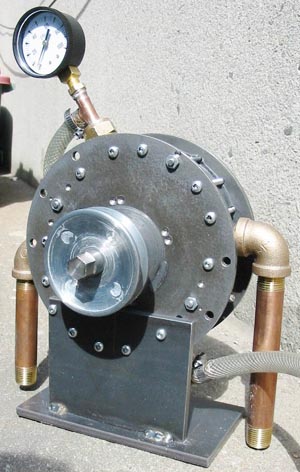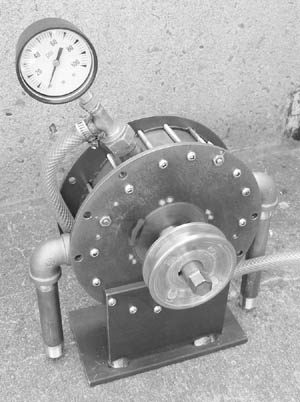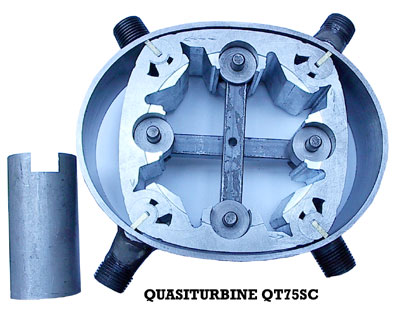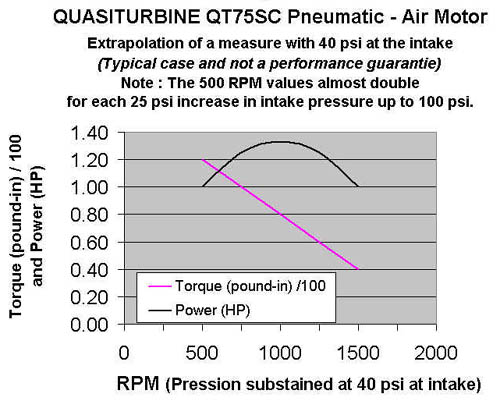

Quasiturbine Model QT75SC pneumatic-steam (similar to the QT50SC Without Carriage, here shown)
Usable with intake sustained pressure as low as 20 to 50 psi!
See the replacement page QT5LSC Pneumatic
QUASITURBINE ZERO
VIBRATION
Model QT75SC Pneumatic
(air motor) / Steam
now available as pre-commercial
prototypes
SEE
ALSO :
SET OF BASIC PARTS (PARTIAL KIT)
FOR ACADEMIC
DEMONSTRATION
PROTOTYPE
RESEARCH APPLICATION PROTOTYPES made by
QUASITURBINE TRONÇONNEUSES INC.
(A qualified manufacturer under a privileged QT-BLADES supply license agreement)
Casier 2804, 3535 Ave Papineau, Montréal Québec H2K 4J9 CANADA
(514) 527-8484 Fax (514) 527-9530
http://quasiturbine.promci.qc.ca
quasiturbine@promci.qc.ca
Those pre-commercial research application prototypes are specially well built.
UNIT
COMPLETE and RUNNING !
Pneumatic (air motor or air engine) - Product description :
The Quasiturbine research application prototype has been developed
from a chainsaw application. Casing and rotor weight
have not been optimized, and weight about 20 pounds (cylindrical outside
measurement are about 7 7/8" in diameter and
2 1/2" thick excluding peripherals). It
has a total 600 cc intake volume per revolution. The rotor and
the cylindrical external casing are built of high quality steel (no aluminium
prototype at this time). All basic prototypes comprise a cylindrical stator bloc, a rotor
and an 3/4-inch diameter shaft throughout. 2 intake ports 1/2"
male NPT pipe threads and 2 exhaust ports 1/2"
male NPT pipe threads. Preferred less than peak 100 psi. Periodic lubrication
required. Ideal for mining industries applications and for air vehicle (air
car).


Quasiturbine Model QT75SC pneumatic-steam (similar to the QT50SC Without Carriage,
here shown)
Usable with intake sustained pressure as low as 20 to 50 psi!

QT75SC Pneumatic shown without the differential and the central shaft.
Quasiturbine Model QT75-SC has a volume of 75 cc per chamber,
and the swept volume is 8 chambers per revolution (4 on the top, 4 on the
bottom), which totalized 600 cc per revolution.
At 1800 RPM, this is 1,1 cubic meter per minute at intake (what ever the
pressure) !
QT75SC -
Measured Pneumatic Characteristic - Air
(A typical value given as indication only. May vary from on QT to an other) :
In the present state of development, one needs to typically apply 10-15 lb/po2
(psi)
at the intake pressure gauge to obtain a free rotation of 500 RPM.
To produce 1 HP at 500 RPM (not the maximum power),
one needs to apply about 40 lb/po2 (psi) at the intake pressure
gauge.
The - effective differential internal pressure - is then about 25 lb/po2
(psi), producing a torque of 120 lb-po.

Model QT75SC Pneumatic (Rotor average diam. 6 in. by 2 in. thickness)
The values vary linearly around this low pressure
point
but must not be inconsiderably extrapolated to high pressures
(Around 1 HP by 25 lb/po2
(psi) still at 500 RPM).
(At 3 times this RPM the power would vary as 3 HP by 25 lb/po2
(psi) effective, which is
theoretically compatible with the non-verified objective to exceed 10 HP at 3000
RPM with only 100 (psi) at intake).
Le débit d’air (non mesuré) consommé par le moteur est alors de 75cc x 8
chambres par tour x 500 tours/min = 300 litres/min
à une pression entre la pression effective de 25 psi et la pression d’entrée de
40 psi.
Pour tirer le plus d’énergie possible de l’air comprimé, il est essentiel de
s’assurer
que la température de l’air à l’entrée de la Quasiturbine est voisine de la
température ambiante,
et même sensiblement plus élevée si possible.
|
Example 1 : RPM = 1000; Pressure = 40 psi ; Pfm = 20 psi
Example 2 : RPM = 3000; Pressure = 100 psi ; Pfm = 50 psi
Extrapolation not verified. |
REMARK ON PNEUMATIC SYSTEM EFFICIENCY
An high efficiency pneumatic motor does not guaranty the high
efficiency of the entire pneumatic system.
All gas heat up during compression and cool down during relaxation.
The cooling effect must not be under-estimate. As an example, a typical 200 bar
(atm.) cylinder
empty adiabatically (without thermalization to ambient temperature) gives at the
end an air so cold
that its volume is then a 1/4 of that of the air once back to the ambient
temperature (isothermal relaxation).
In those temperature conditions at the entrance of a pneumatic motor, the
efficiency is catastrophically low
and the lubricant solidified, increasing considerably the internal engine
friction...
Generally, the reversibility of the compression - relaxation cycle reduces with
an increase in pressure,
which favours for high efficiency consideration the use of the lowest design
pressure possible.
The measurement of the exhaust temperature gives generally a good indication of
the efficiency,
since the minimum of energy lost into the environment correspond to
an exhaust temperature equal (neither inferior, nor superior) to the ambient
temperature.
This condition can be achieve by a slight heating (solar) of the gas before its
entry into the pneumatic motor.
Since the Quasiturbine rotates from pressure as low as 1/10 of atmosphere (bar)
(one psi !),
one understand why the Quasiturbine is so well adapted to high efficiency
system...
Attention : Steam Quasiturbine
has provision for thermal expansions and special care to corrosion.
For this reason, the Steam QT will not at this time perform efficiently in
pneumatic mode engine.
On its part, the pneumatic Quasiturbine will cease if used with steam without
modifications.
Similarly, this pneumatic version must not be used with incompressible fluid
(hydraulic mode)
without having been first modified to avoid seals hydraulic lock.
One day, theses specificity will probably be incorporated in all the
Quasiturbines ?
Steam engine - Product description
:
The Steam Quasiturbine research application prototype is very similar to the
pneumatic one, except for lubrication and corrosion consideration.
Attention : Steam Quasiturbine
has provision for thermal expansions and special care to corrosion.
For this reason, the Steam QT will not at this time perform efficiently in
pneumatic mode engine.
On its part, the pneumatic Quasiturbine will cease if used with steam without
modifications.
Similarly, this steam version must not be used with incompressible fluid
(hydraulic mode)
without having been first modified to avoid seals hydraulic lock.
One day, theses specificity will probably be incorporated in all the
Quasiturbines ?
|
It is the buyer and/or operator
responsibility |
- These prototypes are experimental and are not intended for commercial use.
- They require some monitoring and maintenance (like lubrication).
- The must be operated under the constant supervision of qualified adults.
- Anchor the prototypes well before each start-up.
- Never exceed the limits and suggested conditions of operation.
- Wearing safety glasses, mask and fastener hair is recommended.
- The demonstration room must be well ventilated.
- Check the tightening of the bolts and adapters. Be wary of the rupture
or the decoupling of any of the flexible hoses.
- Have a distant valve allowing to cut the air flow (nitrogen / steam) as
needed.
- Particularly during grinding, it can happen that the
rotor be at a dead point,
and refuses to turn when the pressure is applied.
This situation is unstable and call for urgent pressure release.
Then and in absence of pressure, slightly turn the rotor and pressurize
it again...
- During the demonstration, nothing should approach the engine
and makes the observations at a distance of 50 cm (20 po.) or more.
-
Always remain vigilant!
Leave a message at quasiturbine@promci.qc.ca to
discuss Leasing or Buying,
indicating pneumatic (which gas ?) or steam, and the needs in torque, RPM and
power in known.
(Quasiturbine Tronçonneuses Inc. will not reveal the identity of prospects or buyers, but
those ones are free to do so).
* * * * *
Internal combustion engine - Product description : (Not available for now).
Stirling engine - Product description : (Not available for now).

Quasiturbine Tronçonneuse Pneumatic QT50SC
(In practice, over 5 HP on a 100 psi air line)
Chainsaw
(pneumatic air motor or internal combustion) will not be available before some certification.
* * * * *
Even if the Quasiturbine team do not generally participate
actively to engine integration projects,
you are invited to consult the
A summary of ENGINE INTEGRATION METHODOLOGY
TO A ROLLING FRAME (Including an example)
at :
quasiturbine.promci.qc.ca/QTChassis.htm
| Return to main menu |
Quasiturbine Tronçonneuses Inc.
Casier 2804, 3535 Ave Papineau, Montréal Québec H2K 4J9 CANADA (514) 527-8484
Fax (514) 527-8484
http://quasiturbine.promci.qc.ca
quasiturbine@promci.qc.ca